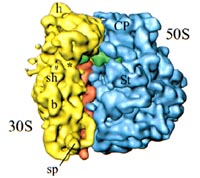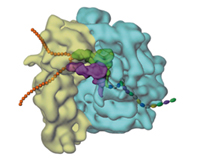Dr. Frank has pioneered
a technique known as cryo-electron microscopy, in which biological
samples are embedded in a thin layer of ice and then carefully examined in
the electron microscope. The technique allows delicate structures like the
ribosome to be preserved in their native state, and provides enough resolution
(fine detail) to allow scientists to study them closely. In order to do this,
thousands of images of individual ribosomes, tilted to a variety of different
angles, were combined using an innovative computer program known as SPIDER,
also developed by Dr. Frank and his associates. The SPIDER program permits
researchers to use the electron microscope to study biological structures
at a level of detail that cannot be easily obtained from other techniques.
As you can see from the
ribosome image (above), these techniques clearly show the shape of the two
subunits of the ribosome (the small subunit is yellow
and the large one is blue in the image).
Dr. Frank's work has made it possible to develop a picture of the exact way
in which the ribosome associates with tRNA (transfer RNA) and mRNA (messenger
RNA) molecules during protein synthesis, as shown below:


